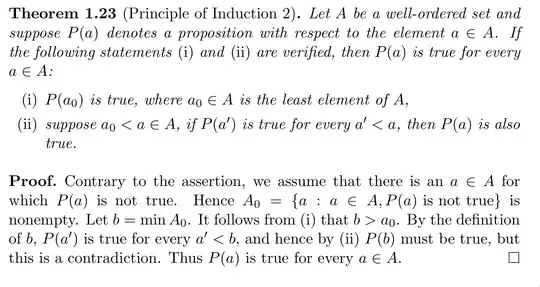This is a follow up from this question.
I want to prove whether the usual "induction theorem" works in a general well-ordered set $A$:
If $(A,\preccurlyeq)$ is a well-ordered chain, $\Phi(\min A)$ is true, and for all $x\in A$, $\Phi(x)\Rightarrow \Phi(x^+)$, then $\Phi(a)$ is true for all $a\in A$.
For $\mathbb N$ it works because apart from the successor, you can also evaluate the "precursor" $$x^-=\max\{a\in A : \text{$a\preccurlyeq x$ and $a\neq x$}\}.$$
Indeed, one can proceed by contradiction, noting that if it is false, $\min\{a\in A : \lnot\Phi(a)\}$ exists (call it $a_0$), but then you get that $\Phi(a_0^-)$ is true, so $\Phi((a_0^-)^+) = \Phi(a_0)$ is true, a contradiction.
(In the case of $\mathbb N$, the maximum always exists because the corresponding set is bounded above and finite, hence my original question.)
When I see this stated for the general case, it is always phrased in the "strong induction" way, and the proof depends on that fact. Here is an example:
So is my (normal) induction statement true? I suspect not now that I think about it, since if we have order type $\omega+1$ (say) we never establish $\Phi(x)$ for the last element by chaining implications together as induction usually does for $\mathbb N$ (i.e., $\Phi(1) \Rightarrow\Phi(2)\Rightarrow\cdots$).
